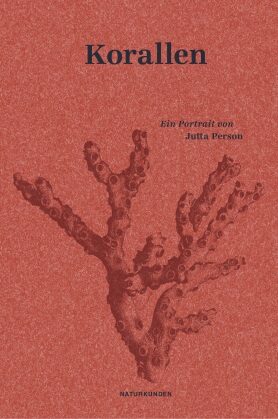Jutta Person
Korallen. Ein Portrait
[Corals: A Portrait]
- Matthes & Seitz Verlag
- Berlin 2019
- ISBN 978-3-95757-697-2
- 189 Pages
- Publisher’s contact details
Sample translations
Fantastic Creatures of the Sea
Corals live in the light zones of the oceans and are therefore relatively easy to reach. The author first approached them carefully on snorkeling excursions, but she was quickly enchanted by the world of corals. She learned how to scuba-dive and discovered a strange, underwater cosmos, where there was a lot of dabbling, swaying, and moving on tentacles … but no interest whatsoever in human beings.” A cosmos that is alive, “and indeed beastly alive,” in which the corals clearly control their own movement rather than simply swaying in the current.
This world does not become any less exotic, although human beings have transported the vocabulary of their human environment under water. And so they find brain, cauliflower, lettuce, elkhorn, and organ pipe corals, as well as dead man’s fingers and broccoli tree coral. The most beautiful specimens have their own portrait in the appendix.
On her excursion into natural history the author reports that in fact it took until the eighteenth century, through the research of the natural scientist Jean-André Peyssonnel, for corals to be recognized as animals. Scientists today classify corals and jellyfish as cnidarians. They consist of numerous polyps that build structures out of limestone, which they live on or in. They subsist on plankton or small fish that they capture with an arrow-like barb and a toxin discharged from their stinging cells (cnidocytes). Each new generation of riff-building corals settles on the remains of the previous one, creating entire islands over the course of tens of thousands of years. Even the rather level-headed Darwin started raving in his description of his insights into the earth-changing power of these corals.
However, people were enthusiastic about corals even much earlier, according to the author, as she shifts from natural to cultural history. Jewelry made of the brilliant red precious corals were already sold beyond the Alps as early as the Iron Age, and in ancient Egypt they were placed in tombs to offer magical protection for the deceased. The more the author looked, the more she found the typical red coral necklaces or entire branches of corals in paintings and on vases, in churches and in the curiosity cabinets of early scholars, as amulets and even as pacifiers and on crocheted artworks.
Jutta Person follows the corals through poetry and literature, finding examples in Ovid and Pliny, as well as in Shakespeare, Jules Verne, and Karl Marx. A wide variety of authors continues to be fascinated by what the cooperation of so many minuscule animals can create. Marx used the countless riff-building corals as an analogy for the masses of workers in early industrial society. And the middle class discovered corals at the same time: as ornamental gems in aquariums.
Of course this beautifully illustrated, coral-red volume cannot close without a rather dismal look at how climate change, overfishing, and tourism impacts corals. Like many before her, however, Jutta Person also found a recipe among the corals for resolving the present-day problems: Let us “forget simplifications and create ramifications.”
Translated by Allison Brown

By Manuela Lenzen
Manuela Lenzen is a freelance science journalist. The main subject areas of her writing are evolution, cognition, and artificial intelligence.
Publisher's Summary
In her colorful animal portrait, Jutta Person plunges deep into the natural and cultural history of these living creatures, whose status as animal, vegetable, or mineral was long uncertain. It is not without reason that corals appeared to be baffling in-between beings that grew on underwater meadows or populated courtly curiosity cabinets as mineral wonders of nature. Jutta Person tells about the coral’s appearance in literature and art, shows how as bony-looking amulets they helped ward off the evil eye, and travels with us to the Andaman and Red Seas. It is an expedition into psychedelic worlds – and into the history and present existence of fascinating sea dwellers that we need to protect more urgently than ever in view of coral bleaching and the death of the reefs.
(Text: Matthes & Seitz Verlag)
